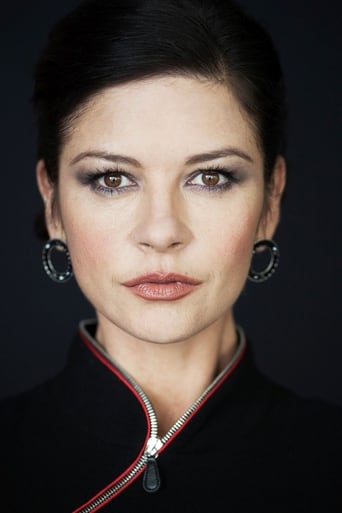BlazeLime
Strong and Moving!
Exoticalot
People are voting emotionally.
PodBill
Just what I expected
Tedfoldol
everything you have heard about this movie is true.
Wuchak
This version of "Titanic" was released to TV in two-parts in November, 1996, a year before James Cameron's version in late 1997. Of course, Cameron's film is one of the greatest successes in cinematic history, both critically and at the box office, so not many people remember this lower-budgeted version. But don't let that make you think this was a cheap movie because it still cost $13 million to make; it's just that the 1997 film cost $200 million. In any case, they're both long movies (and so you have to be in the mood for a looong movie to appreciate either of them). The original TV version of the 1996 film runs 173 minutes while Cameron's runs 194 minutes. However, the main story that takes place in 1912 is about the same length in both versions because the 1996 one doesn't contain the modern-day subplot of the 1997 film.The movie of course details the doomed maiden voyage of the magnificent Titanic from April 10-15, 1912. This is one of the greatest tragedies in human history. There were only enough lifeboats for half of the over 2200 men, women and children aboard. Why? Because the Titanic was so great they thought she was unsinkable. When it was all over only a little over 700 people survived and 1500 people went to their grave in the cold North Atlantic.This is a movie and not a documentary and, as such, includes some fictional drama to hook the viewer. Despite this, it gives more attention to historical detail than Cameron's film. For instance, there really was a woman on board who was suspected of murdering her own child and kidnapping the child of the family for whom she was employed. What she ultimately does negatively impacts the real parents and their daughter, which explains the only first class child who didn't survive.George C. Scott is effective as Captain Edward Smith who explains that the Titanic foreshadowed its fate with its name. He laments, "There's a line often quoted in the newspapers: 'God Himself Could Not Sink This Ship.' She was appropriately named: The Titan's dared to challenge the God's; and for their arrogance, they were cast down into hell."Although an iceberg is what caused the Titanic to sink, Bruce Ismay is often blamed for the tragedy because he allegedly pressured Captain Smith and Chief Engineer Joseph Bell to go faster in order to arrive in New York ahead of schedule and generate positive press. He's painted in a slightly better light in this film than the 1997 version since he's shown helping many people into lifeboats before his escape, as well as his sorrow over the disaster.Unlike Cameron's film, this version details the nearest vessel, the Californian, which has been accused of leaving the people of the Titanic to drown. We don't know for sure why this ship failed to offer succor and probably never will, but we do know that the Californian tried to warn Titanic of the ice in its path and the Titanic's wireless operator responds by saying, "Shut up!" In defense of the Californian, it was trapped in a field of ice and so if it had gone to help the Titanic they would've had to carefully steer around the ice in the dark and, by the time they made it, most of the people on the Titanic would have already frozen to death. In any event, this 1996 version gives an excellent depiction of what likely went down.In addition, the movie depicts John Aster's request to go with his wife and the crew's refusal, as well as a brief part devoted to survivor R. Norris Williams.So this version is worth seeing just to grasp the fuller picture of the tragedy since it contains more historical detail than Cameron's rendition.As for the dramatic subplots, there are about five and they help you view the events on a human level, just as Jack & Rose's escapades do in the 1997 film. The full-length version includes a rape scene, which people criticize, but these types of things happened in the "good ol' days" and, besides, it's there to make a point in that particular story arc. Speaking of which, I was impressed – even inspired – by some of the subtexts, like enlightenment, repentance & forgiveness, the wages of sin, and the question of how a good God allows such suffering and evil, etc.All the cast members rise to the challenge, which include the likes of Peter Gallagher, George C. Scott, Catherine Zeta-Jones, Eva Marie Saint, Marilu Henner, Tim Curry, Roger Rees, Mike Doyle, Sonsee Neu and more.BOTTOM LINE: Since this version of "Titanic" cost $187 million LESS than the famous 1997 version, it obviously lacks the aesthetic appeal of the latter. For instance, the special effects are rather lame by comparison but, at the same time, they're certainly serviceable, considering it's a TV movie and the year it was made. So this version is clearly the lesser film, but that doesn't mean it's unworthy. Its strong points are its historical detail, its competent cast and potent subtexts. I suggest watching them both.GRADE: B+ (keeping in mind it's a TV movie from 1996)
lil_sumia_786
This version of the disaster was actually pretty good and in some ways the best. Instead of just focusing on one story it focuses the storys of three different sets of people and shows their loss as well as their joy.It tells the story of Jamie and Osa and his joy when he finds out that Osa is alive after all. For me their story is the best because it has a happy ending, but the story of Wynn and his lover shows the loss most people faced, and the story of the Allisons and their nanny shows how desperate people get when disaster strikes. Another thing that was good about it was that it doesn't just show the sinking of the ship but also after the ship has sank and the carpathia has come to fetch them.it shows the scenes aboard the carpathia and how people coped with the loss and it also shows the carpathia docking at NY and the scenes afterwards; people trying to find their family members and the press looking for info about the sinking.However the only thing i didn't like about it was the fact that the ship sinks too quickly into the water and it just shows faded shots of people scrambling.It doesn't really show passengers desperation as the ship went into the water like the 1997 version does.
GeorgeSickler
I'm kidding, but the network executive who OK's this turkey should have gone down with the ship.I was born on an April 15 (but not 1912, the date the RMS Titanic sank), so this has been a favorite subject of mine -- beginning when I read Walter Lord's "A Night to Remember" as a kid not too long after it was published in 1955. And then there's that tremendously emotionally charged movie of the same title and based on the book that came out in 1958. I felt like I was there, and experiencing it from the perspective of passengers in steerage, second & first class, as well as the crew.Many others have commented on the factual inaccuracies, wooden acting, and contrived plot developments that supposedly were added to "spice it up," as if this human tragedy of titanic proportions needs "spicing." What bothered me the most were a number of scenes which made me just cringe, fold my arms and slowly shake my head, thinking, "Oh, Come on! Nobody could/would do that and expect to get away with it. Do they really think viewers are so dense to buy this" As just a few examples, and these may or may not be spoilers: Do you really think Capt. Smith would let a passenger (female or male) take steerage control of the ship on a visit to the bridge, just for fun? If he actually did, and it got to the White Star Line in New York, I suspect he would have started his retirement before his last return trip home. Test this on your next cruise: try to go to the bridge and ask to steer the ship for awhile.Do you really think J. Bruce Ismay, the chairman of the White Star Line, would climb down to the boiler room and order more boilers to be fired up for more speed? He would do this to defy the orders of their boss, Capt. Smith? And the crew would go along with it? No crew would go against the orders of their next in command, as ordered by their captain. Get real.Bruce Ismay is another real person just trashed by this movie. He did save himself by climbing into a lifeboat when there were no other women or children at that station (although there were plenty elsewhere). At the inquiries, he said he did that so that the full story could be told. Nobody believed that. He lost his job at White Star; White Star was absorbed by Cunard, and I understand Ismay died alone and lonely in the U.K. in the 1950s.The contrived character Simon "Snidley Whiplash" Doonan is so blatantly obnoxious and evil as a member of the ship's passenger crew, that he should have been reported by someone -- but never was. Instead, he strolls into cabins at his leisure and takes his time robbing first cabin passengers. And gets away with it.The often mentioned rape-in-the-shower scene: What are the odds? The Titanic was the largest ship afloat, with well over 1,500 passengers on board. The vast majority were in steerage, where the rape scene occurred. "Steerage" on the Titanic was better than 2nd class on other liners: the food was better, the service and cabins were better. . . . most passengers never had electric light or indoor plumbing at home. They had it here for the first time. If there were communal showers -- and I don't think there were -- I suspect they'd be in constant use as a real novelty. And they'd be segregated by sex.So, here's this gal in a communal shower. But she's ALL BY HERSELF -- in a steerage section filled with several hundred other women who have never had the experience of a hot shower before. And "Snidley" Simon casually strolls in without a care or fear in the world and rapes her --and smirkingly gets away with it.Oh, come on. What are the odds? And then there's the business with Frederick Fleet in the lookout tower being ordered to release his binoculars for their return to the bridge, as if that were a mega blunder and contributing factor to the disaster.Oh, pleeeeeeze! What bridge command on any ship would order the lookout to give up his binoculars? Especially after receiving ice warnings. What does the bridge want to see that's different than what the lookout NEEDS to see? They could call on the phone and ask Fleet to look.Anyway, on the night of April 14, there was no moon, but a dead-calm sea and a velvet sky blanketed with stars. The two lookouts didn't have, and didn't need, binoculars because it was pitch black. What tipped Fleet off was that, dead ahead, there was a growing blackness due to an absence of stars. It was the iceberg, which led to his clanging the emergency bell in the lookout tower and calling the bridge.If there were moonlight, they would have seen it sooner. If the sea were a bit rougher, they would have seen the white foam of the churn hitting the outline of the base of the burg.To claim, as this film does, that the lookout was forced to give up the binoculars is a lie and a gross disservice to the memories of the officers and crew of the RMS Titanic.Anyone who wants to understand and be profoundly moved by this tragedy as experienced by realistic and representative folks of all classes, crew and officers -- try "A Night to Remember." It doesn't need shower scenes, rapes, "Snidley Whiplash" or other contrived plots to make it "interesting."
Mgme Gelta
Okay, before I start, I love the MOVIE Titanic, by James Cameron. I brought this DVD by mistake and ended up liking it. It really is a good movie/mini-series. It pales in comparison to the movie, but it is very enjoyable.It is very down-to-earth. It has a more realistic take on the whole disaster. It dosn't just show you one random love story between two strangers, but a more varied plot-line.However, It is kind of confusing to follow but overall, 8 out of 10.(P.S. The cast is great, especially Tim Curry & Marilu Henner....all of the cast gave amazing performances)







